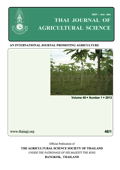Weed Control Efficiency of Bioherbicides and Mulches on Yield and Yield Components of Tomato
Main Article Content
Abstract
An experiment was conducted to study the response of weed control efficiency of bioherbicides and mulches on yield and yield components of tomato, at the New Developmental Farm (NDF), University of Agriculture Peshawar, Pakistan during summer 2011. The effect of extracts of Parthenium hysterophorus, Eucalyptus camaldulensis, and Helianthus annuus and wheat straw and Eucalyptus camaldulensis mulches in relation to control was studied in tomato crop. The analysis of the data clarifies that the plants treated with wheat straw mulch showed highest plant height (48.59 m), number of branches plant-1 (10.19), number of days (49.62) to first fruit, number of fruits plant-1 (12.57) and tomato yield (28,023 kg ha-1), while the lowest days (43.48) to first fruit set, number of days (39.18) to first flowering, weed density at 50 days after transplantation (23.3 m-2) and weed density 120 days after transplanting (44.3) were recorded in plots treated with wheat straw mulch. The control plots showed maximum number of days (43.95) to first flowering, days (49.62) to first fruit, weed density at 50 days after transplantation (157.6 m-2) with minimum number of fruit plant-1 (4.69), with lowest tomato yield (22,697 kg ha-1). From the results obtained, it is concluded that mulches and bioherbicides enhance the yield and yield components of tomato and hence wheat straw mulch is recommended for realizing better yield of tomato.


